Huiqiang Sun
BokehFlow: Depth-Free Controllable Bokeh Rendering via Flow Matching
Nov 19, 2025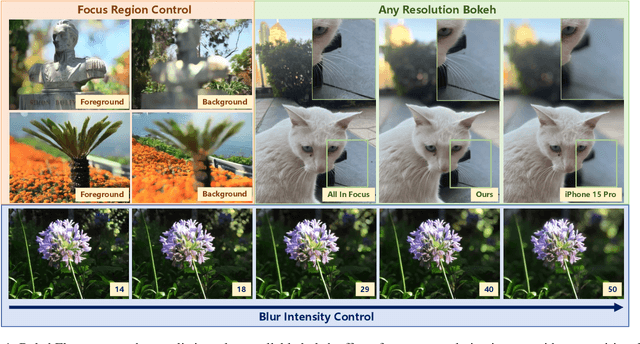

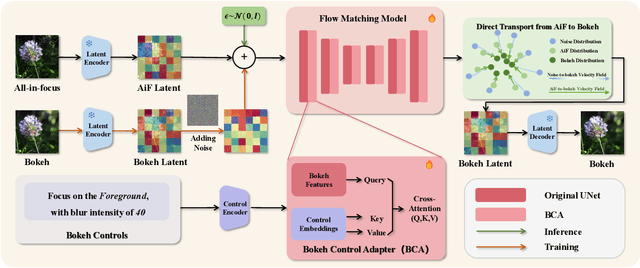

Abstract:Bokeh rendering simulates the shallow depth-of-field effect in photography, enhancing visual aesthetics and guiding viewer attention to regions of interest. Although recent approaches perform well, rendering controllable bokeh without additional depth inputs remains a significant challenge. Existing classical and neural controllable methods rely on accurate depth maps, while generative approaches often struggle with limited controllability and efficiency. In this paper, we propose BokehFlow, a depth-free framework for controllable bokeh rendering based on flow matching. BokehFlow directly synthesizes photorealistic bokeh effects from all-in-focus images, eliminating the need for depth inputs. It employs a cross-attention mechanism to enable semantic control over both focus regions and blur intensity via text prompts. To support training and evaluation, we collect and synthesize four datasets. Extensive experiments demonstrate that BokehFlow achieves visually compelling bokeh effects and offers precise control, outperforming existing depth-dependent and generative methods in both rendering quality and efficiency.
Generative Photographic Control for Scene-Consistent Video Cinematic Editing
Nov 17, 2025Abstract:Cinematic storytelling is profoundly shaped by the artful manipulation of photographic elements such as depth of field and exposure. These effects are crucial in conveying mood and creating aesthetic appeal. However, controlling these effects in generative video models remains highly challenging, as most existing methods are restricted to camera motion control. In this paper, we propose CineCtrl, the first video cinematic editing framework that provides fine control over professional camera parameters (e.g., bokeh, shutter speed). We introduce a decoupled cross-attention mechanism to disentangle camera motion from photographic inputs, allowing fine-grained, independent control without compromising scene consistency. To overcome the shortage of training data, we develop a comprehensive data generation strategy that leverages simulated photographic effects with a dedicated real-world collection pipeline, enabling the construction of a large-scale dataset for robust model training. Extensive experiments demonstrate that our model generates high-fidelity videos with precisely controlled, user-specified photographic camera effects.
Dual-Camera All-in-Focus Neural Radiance Fields
Apr 23, 2025Abstract:We present the first framework capable of synthesizing the all-in-focus neural radiance field (NeRF) from inputs without manual refocusing. Without refocusing, the camera will automatically focus on the fixed object for all views, and current NeRF methods typically using one camera fail due to the consistent defocus blur and a lack of sharp reference. To restore the all-in-focus NeRF, we introduce the dual-camera from smartphones, where the ultra-wide camera has a wider depth-of-field (DoF) and the main camera possesses a higher resolution. The dual camera pair saves the high-fidelity details from the main camera and uses the ultra-wide camera's deep DoF as reference for all-in-focus restoration. To this end, we first implement spatial warping and color matching to align the dual camera, followed by a defocus-aware fusion module with learnable defocus parameters to predict a defocus map and fuse the aligned camera pair. We also build a multi-view dataset that includes image pairs of the main and ultra-wide cameras in a smartphone. Extensive experiments on this dataset verify that our solution, termed DC-NeRF, can produce high-quality all-in-focus novel views and compares favorably against strong baselines quantitatively and qualitatively. We further show DoF applications of DC-NeRF with adjustable blur intensity and focal plane, including refocusing and split diopter.
Free4D: Tuning-free 4D Scene Generation with Spatial-Temporal Consistency
Mar 26, 2025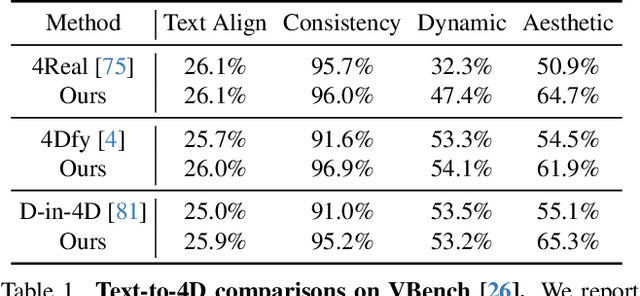
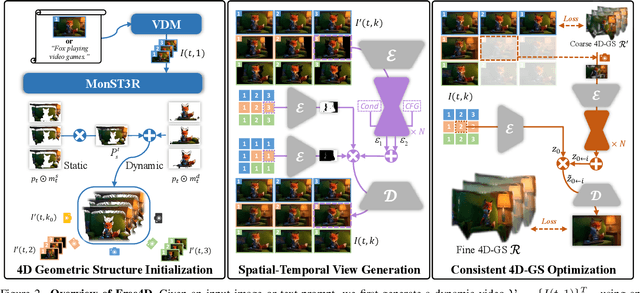
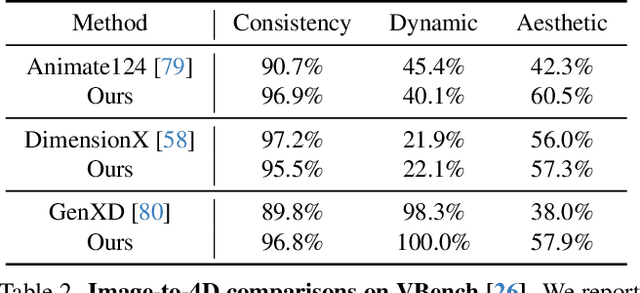
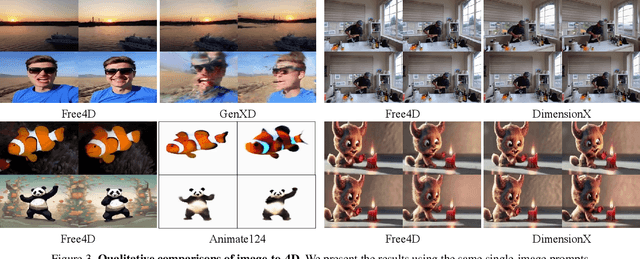
Abstract:We present Free4D, a novel tuning-free framework for 4D scene generation from a single image. Existing methods either focus on object-level generation, making scene-level generation infeasible, or rely on large-scale multi-view video datasets for expensive training, with limited generalization ability due to the scarcity of 4D scene data. In contrast, our key insight is to distill pre-trained foundation models for consistent 4D scene representation, which offers promising advantages such as efficiency and generalizability. 1) To achieve this, we first animate the input image using image-to-video diffusion models followed by 4D geometric structure initialization. 2) To turn this coarse structure into spatial-temporal consistent multiview videos, we design an adaptive guidance mechanism with a point-guided denoising strategy for spatial consistency and a novel latent replacement strategy for temporal coherence. 3) To lift these generated observations into consistent 4D representation, we propose a modulation-based refinement to mitigate inconsistencies while fully leveraging the generated information. The resulting 4D representation enables real-time, controllable rendering, marking a significant advancement in single-image-based 4D scene generation.
DreamMover: Leveraging the Prior of Diffusion Models for Image Interpolation with Large Motion
Sep 15, 2024
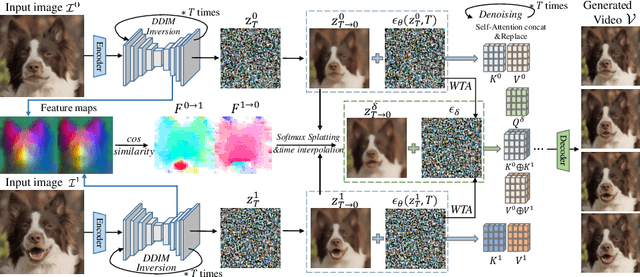

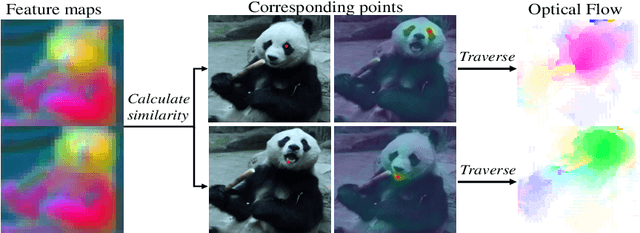
Abstract:We study the problem of generating intermediate images from image pairs with large motion while maintaining semantic consistency. Due to the large motion, the intermediate semantic information may be absent in input images. Existing methods either limit to small motion or focus on topologically similar objects, leading to artifacts and inconsistency in the interpolation results. To overcome this challenge, we delve into pre-trained image diffusion models for their capabilities in semantic cognition and representations, ensuring consistent expression of the absent intermediate semantic representations with the input. To this end, we propose DreamMover, a novel image interpolation framework with three main components: 1) A natural flow estimator based on the diffusion model that can implicitly reason about the semantic correspondence between two images. 2) To avoid the loss of detailed information during fusion, our key insight is to fuse information in two parts, high-level space and low-level space. 3) To enhance the consistency between the generated images and input, we propose the self-attention concatenation and replacement approach. Lastly, we present a challenging benchmark dataset InterpBench to evaluate the semantic consistency of generated results. Extensive experiments demonstrate the effectiveness of our method. Our project is available at https://dreamm0ver.github.io .
Dynamic Neural Radiance Field From Defocused Monocular Video
Jul 08, 2024Abstract:Dynamic Neural Radiance Field (NeRF) from monocular videos has recently been explored for space-time novel view synthesis and achieved excellent results. However, defocus blur caused by depth variation often occurs in video capture, compromising the quality of dynamic reconstruction because the lack of sharp details interferes with modeling temporal consistency between input views. To tackle this issue, we propose D2RF, the first dynamic NeRF method designed to restore sharp novel views from defocused monocular videos. We introduce layered Depth-of-Field (DoF) volume rendering to model the defocus blur and reconstruct a sharp NeRF supervised by defocused views. The blur model is inspired by the connection between DoF rendering and volume rendering. The opacity in volume rendering aligns with the layer visibility in DoF rendering.To execute the blurring, we modify the layered blur kernel to the ray-based kernel and employ an optimized sparse kernel to gather the input rays efficiently and render the optimized rays with our layered DoF volume rendering. We synthesize a dataset with defocused dynamic scenes for our task, and extensive experiments on our dataset show that our method outperforms existing approaches in synthesizing all-in-focus novel views from defocus blur while maintaining spatial-temporal consistency in the scene.
3D Multi-frame Fusion for Video Stabilization
Apr 19, 2024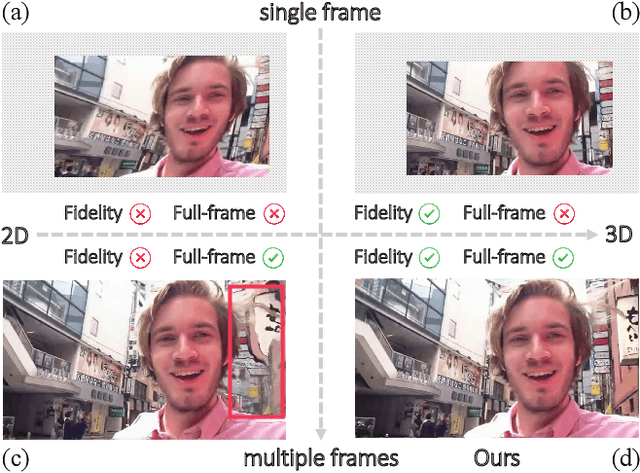
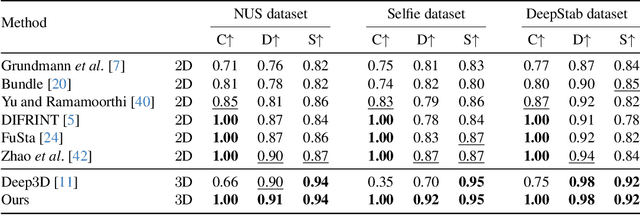
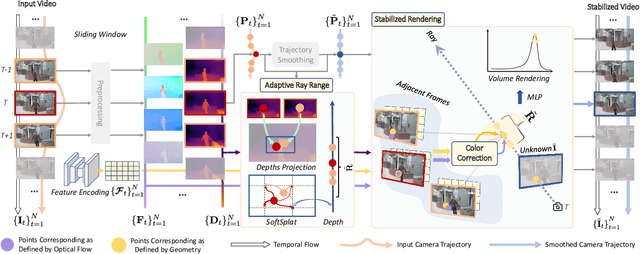

Abstract:In this paper, we present RStab, a novel framework for video stabilization that integrates 3D multi-frame fusion through volume rendering. Departing from conventional methods, we introduce a 3D multi-frame perspective to generate stabilized images, addressing the challenge of full-frame generation while preserving structure. The core of our approach lies in Stabilized Rendering (SR), a volume rendering module, which extends beyond the image fusion by incorporating feature fusion. The core of our RStab framework lies in Stabilized Rendering (SR), a volume rendering module, fusing multi-frame information in 3D space. Specifically, SR involves warping features and colors from multiple frames by projection, fusing them into descriptors to render the stabilized image. However, the precision of warped information depends on the projection accuracy, a factor significantly influenced by dynamic regions. In response, we introduce the Adaptive Ray Range (ARR) module to integrate depth priors, adaptively defining the sampling range for the projection process. Additionally, we propose Color Correction (CC) assisting geometric constraints with optical flow for accurate color aggregation. Thanks to the three modules, our RStab demonstrates superior performance compared with previous stabilizers in the field of view (FOV), image quality, and video stability across various datasets.
DyBluRF: Dynamic Neural Radiance Fields from Blurry Monocular Video
Mar 19, 2024Abstract:Recent advancements in dynamic neural radiance field methods have yielded remarkable outcomes. However, these approaches rely on the assumption of sharp input images. When faced with motion blur, existing dynamic NeRF methods often struggle to generate high-quality novel views. In this paper, we propose DyBluRF, a dynamic radiance field approach that synthesizes sharp novel views from a monocular video affected by motion blur. To account for motion blur in input images, we simultaneously capture the camera trajectory and object Discrete Cosine Transform (DCT) trajectories within the scene. Additionally, we employ a global cross-time rendering approach to ensure consistent temporal coherence across the entire scene. We curate a dataset comprising diverse dynamic scenes that are specifically tailored for our task. Experimental results on our dataset demonstrate that our method outperforms existing approaches in generating sharp novel views from motion-blurred inputs while maintaining spatial-temporal consistency of the scene.
Make-It-4D: Synthesizing a Consistent Long-Term Dynamic Scene Video from a Single Image
Aug 20, 2023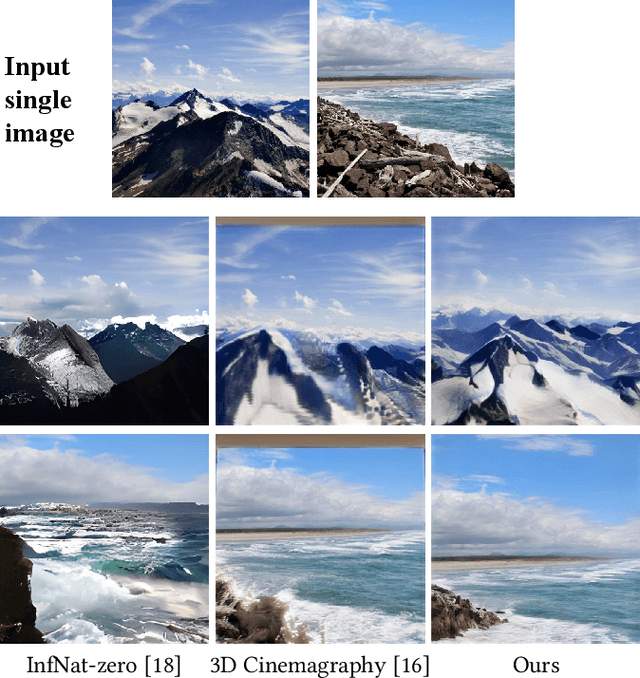

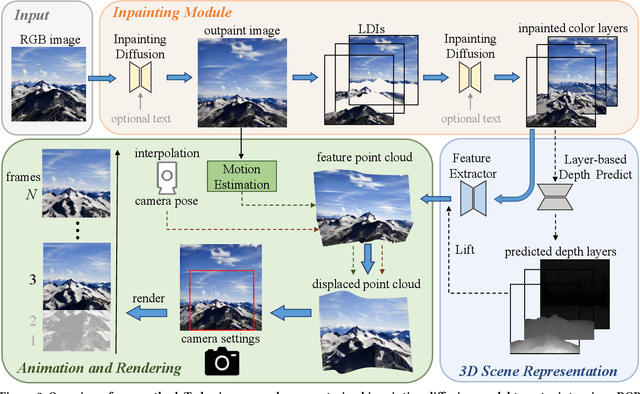

Abstract:We study the problem of synthesizing a long-term dynamic video from only a single image. This is challenging since it requires consistent visual content movements given large camera motions. Existing methods either hallucinate inconsistent perpetual views or struggle with long camera trajectories. To address these issues, it is essential to estimate the underlying 4D (including 3D geometry and scene motion) and fill in the occluded regions. To this end, we present Make-It-4D, a novel method that can generate a consistent long-term dynamic video from a single image. On the one hand, we utilize layered depth images (LDIs) to represent a scene, and they are then unprojected to form a feature point cloud. To animate the visual content, the feature point cloud is displaced based on the scene flow derived from motion estimation and the corresponding camera pose. Such 4D representation enables our method to maintain the global consistency of the generated dynamic video. On the other hand, we fill in the occluded regions by using a pretrained diffusion model to inpaint and outpaint the input image. This enables our method to work under large camera motions. Benefiting from our design, our method can be training-free which saves a significant amount of training time. Experimental results demonstrate the effectiveness of our approach, which showcases compelling rendering results.
3D Cinemagraphy from a Single Image
Mar 10, 2023


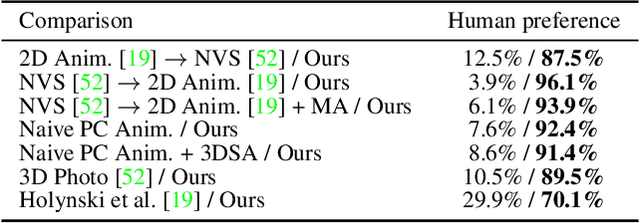
Abstract:We present 3D Cinemagraphy, a new technique that marries 2D image animation with 3D photography. Given a single still image as input, our goal is to generate a video that contains both visual content animation and camera motion. We empirically find that naively combining existing 2D image animation and 3D photography methods leads to obvious artifacts or inconsistent animation. Our key insight is that representing and animating the scene in 3D space offers a natural solution to this task. To this end, we first convert the input image into feature-based layered depth images using predicted depth values, followed by unprojecting them to a feature point cloud. To animate the scene, we perform motion estimation and lift the 2D motion into the 3D scene flow. Finally, to resolve the problem of hole emergence as points move forward, we propose to bidirectionally displace the point cloud as per the scene flow and synthesize novel views by separately projecting them into target image planes and blending the results. Extensive experiments demonstrate the effectiveness of our method. A user study is also conducted to validate the compelling rendering results of our method.
 Add to Chrome
Add to Chrome Add to Firefox
Add to Firefox Add to Edge
Add to Edge